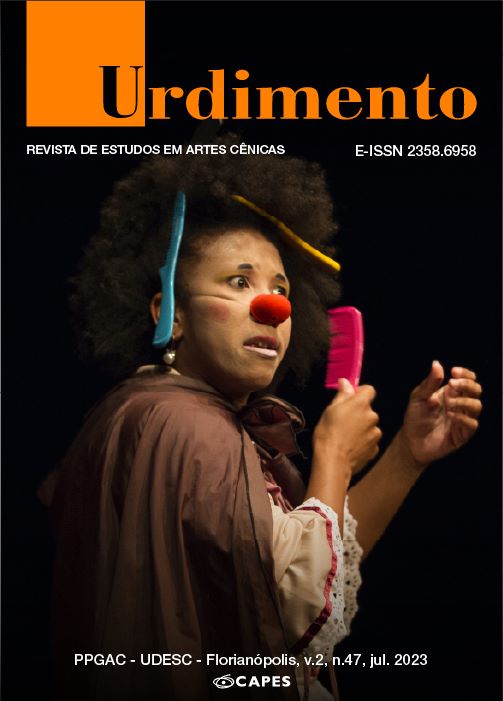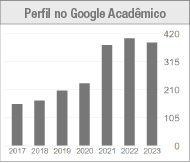A amizade como forma de resistência: reflexões sobre a peça circense Amista' (2021)
DOI:
https://doi.org/10.5965/1414573102472023e0102Palavras-chave:
Circo, Arte de rua, Arte política, CorpoResumo
O seguinte trabalho buscou desenvolver uma série de análises e reflexões a partir da peça circense Amista' (2021) de Tomi Soko, na qual se desenrola a relação íntima e afetiva de três malabaristas de semáforos. Foi interessante pensar a decisão política de criar a partir desse ponto de partida, pois as tensões por dinheiro, a competição entre artistas de rua e a disputa por reconhecimento são expostas ao longo da obra. O artigo foi estruturado em três eixos onde o político adquire conotações específicas: o tema, a linguagem e o processo criativo; perspectivas que por sua vez se alimenta. Fazendo o caminho inverso à encenação, partimos do resultado visível para mergulhar no processo de investigação inicial da obra, colocando no centro a questão sobre a relação entre os saberes corporais dos malabaristas de semáforos e os referidos eixos.
Downloads
Referências
AGAMBEN, Giorgio. ¿Qué es un dispositivo?. Ciudad Autónoma de Buenos Aires: Adriana Hidalgo Editora, 2016.
CORNAGO, Óscar. ¿Y después de la performance qué? Público y teatralidad a comienzos del siglo XXI. Urdimento - Revista de Estudos em Artes Cênicas, Florianópolis, v. 1, n. 26, p. 20-41, jul. 2016. Disponible en: https://doi.org/10.5965/1414573101262016020. Consultado el: 27 jul. 2023.
DEBORD, Guy. La sociedad del espectáculo. Ciudad Autónoma de Buenos Aires: La Marca Editora, 1995.
DIEGUEZ, Ileana. Escenarios limítales. Teatralidades, performatividades, políticas. México D. F.: Paso de gato, 2014.
FLORES, Valeria. La intimidad del procedimiento. Escritura, lesbiana, sur, como prácticas de sí. Badebec, v. 6, n. 11, p. 230-249, 2016. Disponible en: http://hdl.handle.net/2133/15255. Consultado el: 27 jul. 2023.
GAGO, Verónica. ¿Quién es y cómo piensa Bifo?. Entrevista a Franco “Bifo” Berardi. Lavaca, [s. l.], 26 feb. 2008.
Disponible en: https://lavaca.org/notas/quien-es-y-como-piensa-bifo/. Consultado el: 27 jul. 2023.
GROYS, Boris. Volverse público: las transformaciones del arte en el ágora contemporánea. Ciudad Autónoma de Buenos Aires: Caja Negra, 2018.
INFANTINO, Julieta. Circo en Buenos Aires: cultura, jóvenes y políticas en disputa. Ciudad Autónoma de Buenos Aires: Inteatro, 2014.
INFANTINO, Julieta, SÁEZ, Mariana, SCHWINDT SCIOLI, Clarisa, comp.. Pedagogías Circenses. Experiencias, trayectorias y metodologías. Comp. julieta Infantino, Mariana Sáez, Clarisa Schwindt Scioli. La Plata: Editorial Club Hem, 2021.
INFANTINO, Julieta. “El arte callejero no es delito”: procesos de politización de la cultura en la ciudad de buenos aires, argentina. Etnografica, [s. l.], v. 3, n. 25, p. 657-679, 1 out. 2021.
Disponible en: https://doi.org/10.4000/etnografica.10614. Consultado el: 25 jul. 2023.
LIEVENS, Bauke. Between Being and Imagining: 2013-2017. Disponible en: https://www.circusdialogue.com/. Consultado el: 30 de oct. 2022.
MANCILLA, Claudio Andrés Barría. Geopoética dos sentidos, a/r/tografia e o patrimoniável em chave descolonial: por uma poética do sul. Poiésis, [s. l.], v. 20, n. 34, p. 87, dez. 2019.
Disponible en: https://doi.org/10.22409/poiesis.v20i34.38312.
NEGRI, Francisco. (Otras) formas de poner el cuerpo: circo escritura y herencia. Jornadas Internacionales/Nacionales de Historia, Arte y Política 2021. Universidad Nacional del Centro de la Provincia de Buenos Aires. Tandil. Disponible en: https://www.academia.edu/80312919/_Otras_Formas_de_poner_el_cuerpo_circo_escritura_y_herencia_.
NEGRI, Francisco. Escribir circo como se construye un hogar. Pistas de circo, Argentina, Escrito #0, 2022. Disponible en: www.pistasdecirco.com/francisconegri.
PIEL DE LAVA. La creación grupal. En: AJAKA, Alberto … [et.al.]. Detrás de Escena. Ciudad Autónoma de Buenos Aires: Excursiones, 2015, p. 125-130.
RANCIÈRE, Jacques. El reparto de lo sensible: estética y política. Buenos Aires: Prometeo libros, 2014.
Publicado
Como Citar
Edição
Seção
Licença
Copyright (c) 2023 Urdimento: Revista de Estudos em Artes Cênicas

Este trabalho está licenciado sob uma licença Creative Commons Attribution 4.0 International License.
Declaração de Direito Autoral
Os leitores são livres para transferir, imprimir e utilizar os artigos publicados na Revista, desde que haja sempre menção explícita ao(s) autor (es) e à Urdimentoe que não haja qualquer alteração no trabalho original. Qualquer outro uso dos textos precisa ser aprovado pelo(s) autor (es) e pela Revista. Ao submeter um artigo à Urdimento e tê-lo aprovado os autores concordam em ceder, sem remuneração, os seguintes direitos à Revista: os direitos de primeira publicação e a permissão para que a Revista redistribua esse artigo e seus meta dados aos serviços de indexação e referência que seus editores julguem apropriados.
Este periódico utiliza uma Licença de Atribuição Creative Commons– (CC BY 4.0)




